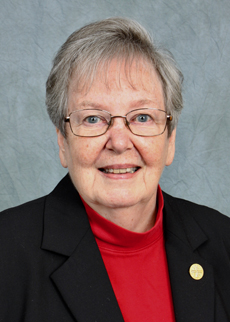Mass, Eucharist provide healing we need

Sister Sandra Brunenn, OSB
Living the Word l Sister Sandra Brunenn, OSB
Twenty-Eighth Sunday in Ordinary Time/Oct. 9
2 Kings 5:14-17; Psalm 98:1,2-3,3-4; 2 Timothy 2:8-13; Luke 17:11-19
Today’s Gospel presents the familiar story of Jesus healing 10 lepers. Jesus performed dozens of miracles, but his curing of lepers holds a special place in the Christian imagination. One reason for this is the dramatic nature of leprosy: lepers then, and to this day, live their lives marginalized from family, friends, and normal casual relationships. They are ostracized, isolated and shunned by others. So to experience healing is more than a medical miracle: it restores life with and in the community. It is a renewal of relationship with family, friends, and community . . . even with oneself.
Imagine the hope that must have filled the hearts of the lepers as they followed Jesus’ command to go and show themselves to the priests! At first thought, the order of Jesus seems puzzling. Why, we may wonder, did he send them to the priests? This is because, in the Jewish tradition, the priests’ affirmation of the cure was needed before they would be welcomed home.
All 10 lepers were healed. The course of their lives was reset — they could now move from the margins into the flow of the community’s everyday life. They could go home! I wonder what those homecomings were like . . . and how their lives evolved after that.
One of them — a foreigner, Jesus says — returned to him in praise and thanksgiving. And it is this one whom Jesus praises! He accepts the recognition of the grateful leper and praises him for his thankfulness to God. I believe Jesus recognizes that this leper has truly been fully healed and brought to a new inner life that will not be taken from him. His gratitude in this moment reflects an attitude toward life that will lead him to continue to live in the path of joy, thanksgiving, and openness to surprise. It is a saving grace!
THANKS AND GRATITUDE
It occurs to me that our recent experience of the pandemic has similarities with the experience of the 10 lepers. We, too, have been isolated from each other and marginalized in many ways. Students have not had normal social interactions; adults have been separated from co-workers they usually associate with; all of us have missed ordinary opportunities to meet with neighbors and family members. We have even endured suffering and loss while separated from each other. We have all been impacted.
“Perhaps today’s Gospel is a call to each of us to take time to give thanks for the connections that are being restored. . . . Join one another in the great prayer of gratitude: the celebration of the Eucharist. Be aware of how much this attitude of praise and gratitude permeates the words and song of this Sunday’s Eucharist.”
Perhaps today’s Gospel is a call to each of us to take time to give thanks for the connections that are being restored; even to recognize and be grateful for blessings received during the past two years of pandemic.
As we approach Sunday, we might imagine Jesus inviting us to “come, show yourself to your faith community.” Join one another in the great prayer of gratitude: the celebration of the Eucharist. Be aware of how much this attitude of praise and gratitude permeates the words and song of this Sunday’s Eucharist. For example, in the responsorial psalm we pray, “Sing joyfully to the Lord, break into song; sing praise.” And in the Alleluia verse before the Gospel: “In all circumstances, give thanks, for this is the will of God for you in Christ Jesus.”
Would you like support in developing an attitude of gratitude? Check out the website of Benedictine Brother David Steindl-Rast, gratefulness.org. I especially recommend a five-minute video by Brother David on that site, “A Grateful Day.” It will open your eyes and heart to be grateful!
—
SISTER SANDRA BRUNENN, OSB, is director of initial formation for the Sisters of St. Benedict of St. Mary Monastery, Rock Island. She has also served as a teacher, spiritual director, and pastoral minister, and was prioress of her Benedictine community from 2012 to 2020.





